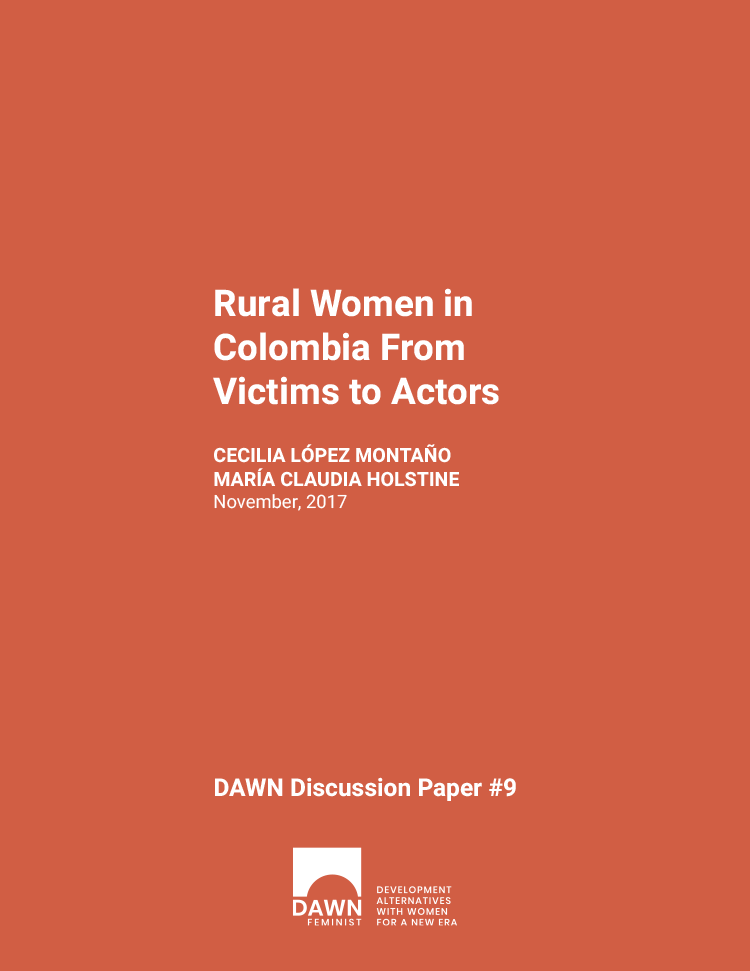Introduction
The Colombian conflict is frequently described as complex, long-lasting, and therefore, difficult to define in simple words. Even now, when the peace process advances shifting between successes and failures, analysts still have very different interpretations of its causes and dimension, as well as of the costs of the war and the benefits of peace. However, there is no dissent concerning women’s situation in the armed conflict. In this aspect, Colombia seems to follow the book; their experience is strikingly similar that of women in other wars around the world. Negative gender bias on female war victims, on their contribution, the costs they have assumed, their new roles, and certainly, their needed but often ignored involvement both in war and peace are part of the universal inequality that prevails all over the world between women and men. Nevertheless, a deeper analysis of this conflict allows to identify specificities of women’s participation in the Colombian case.
Stewart [2010b] reviews the numerous and complex ways in which women engage in and are affected by armed conflicts. These are often ignored by analysts, who limit their view to the role of women as a weapon of war, and referring almost exclusively to the sexual abuses they are subjected to. The economic, social, and political conditions in which women live are usually set aside under the covert hypothesis that they play a minimal role in their societies.
Many documents have been written about this nation’s armed conflict, not only by Colombians but also by international experts. But only a few —not even those written by women’s organizations— analyze the intrinsic causes of gender-based violence in the armed confrontation. They diligently describe violence within the traditional definition of sexual violence —rape, sexual slavery, forced prostitution, etc.—. Although some research recognizes that women play a very important and sometimes unrecognized role, very few consider Gender-Based Violence Against Women (GBVAW) in its widest conception. In consequence, they overlook economic, social, political, and cultural aspects related with the situation of women in war.
Therefore, throughout the peace process with the Revolutionary Armed Forces of Colombia (FARC)1 and the beginning stage of the dialogues with the National Liberation Army (ELN),2 it is difficult to understand why women barely partook in the negotiations despite representing 50% plus of the victims; thus, female leaders are absent from the front line of post conflict actions, or are marginally included in follow-up and evaluation of this accord’s 3 implementation. Their absence comes as a product of systematic disregard for their importance during the conflict, the role they can play during transition from war to post conflict, and their potential contribution to peace.
The main hypothesis of this chapter is that only when widening the spectrum of analysis of violence against women in the middle of the Colombian conflict, and only if including the nation’s economic, social, and political factors of the time, can one determine the costs for these women and their contributions to peacebuilding during the war. Only then, will GBVAW be fully understood and women’s role in the conflict will be truly valued. Thus, it is key to identify all the roles females played during the conflict as combatants, civilians, victims, and even perpetrators.
One of the most significant conclusions of this research is that Colombian women are not only victims —as they are exclusively considered—, but in fact, crucial actors within the conflict. A role that may also be unknown in other armed conflicts around the world, given that the most outstanding similarity in all of them is the historical underestimation of women’s situation.
Unquestionably, a key deduction is that only when adding the GBVAW’s Political Economy perspective —which entails a broader analysis that includes economic, political, and social variables that may lead to violence— a better understanding of gender violence is achieved not only during conflict, but in times of peace.
This chapter has been organized in six sections. After this introduction, section two will summarize the main characteristics of the Colombian conflict; section three is an analysis of the role of men and their contribution to GBVAW in Colombia; section four analyzes the role of women as actors and victims; the fifth refers to the Political Economy of Violence Against Women in this nation’s conflict; the sixth discusses the role of women in the peace process; and the seventh presents final thoughts on this important issue.
1 The FARC is known as a leftist guerrilla group founded in 1964, and as the largest insurgency in the country.
2 The ELN is a Marxist guerrilla group, the second largest in Colombia.
3 The Peace Accord is how this study will reference the 2016 peace agreement signed between the Colombian Government and the FARC. The 310-page document was initially rejected by a popular vote in October 2016, after which, the government invited opposition parties to weigh-in on its content. Some changes were accepted by FARC and the final text was signed by the parties, and ratified by Congress in November 2016. The Peace Accord includes a series of compromises for reforms on land, political participation, anti-drug policies, and other points. A six-person committee is in charge of supervising compliance; only one member is a woman. However, the committee has publicly stated that they will permanently consult women’s organizations in order to guarantee the reforms will incorporate women’s needs [El Espectador 2016].

